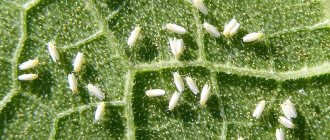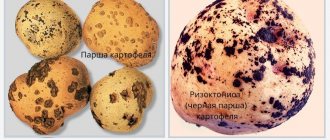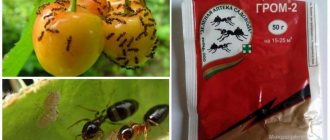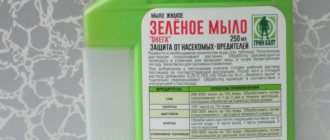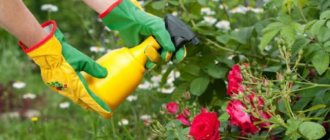Features of the drug Fitoverm
Fitoverm is a modern insectoacaricide, characterized by a contact-intestinal spectrum of action . It is thanks to this that the product can be used against various types of insects and mites. After treatment, the active substance quickly penetrates the skin of insects and into the gastrointestinal tract when eating leaves. The main active ingredient is Aversectin C, which causes paralysis in animals. After using this product, pests lose their ability to feed 7-8 hours after treatment. And within two days they die .
The Fitoverm insecticide decomposes inside the soil a month after treatment, and on the surface of plants after three days. This drug can be used even when plants are flowering. It is important to note that due to the rapid destruction of the main component, plants should be sprayed with phytoverm as needed. After the first treatment, only adults die, but larvae, nymphs and pupae will remain on the leaves. When they begin to feed on their own, you will need to spray again. This product is often purchased for treatment against whiteflies, mites, aphids and other pests .
Fitoverm is an effective drug of the fourth generation, which is distinguished by its biological effect. It was created on the basis of metabolic products of soil microorganisms, so it is practically safe, unlike other chemicals. During processing, people must follow basic safety rules - avoid contact with skin and mucous membranes. Before use, it is important to read the instructions and become familiar with the dosage of the drug.
Perhaps it is useful for all gardeners to know how to use potassium sulfate fertilizer.
Composition, release form
The product is produced. The insecticide is available in different forms, but most often it is a colorless liquid. The main component of the drug is Aversectin S.
Fitoverm can be packaged as follows:
- ampoules with a volume of 2 to 5 ml;
- bottles (up to 400 ml);
- canisters, maximum capacity – 5 l;
- isolated bags (concentrated emulsion);
- Fitoverm P powder, often used against nematodes.
To treat indoor plants with insecticide, 1 ampoule of minimum volume is enough. The amount of funds for open ground crops significantly exceeds the amount spent on home flowers.
It is more convenient to prepare a solution for the garden using canister packaging. The type of parasitic insects should also be taken into account. This will ensure the correct dosage when diluting Fitoverm.
Area of action of the drug Fitoverm
Fitoverm is a drug with a pronounced odor that is used for various purposes . It can be used not only to protect indoor plants, but also various crops. Fitoverm ke effectively copes with the following pests:
- Colorado beetle;
- white butterfly and cabbage butterfly;
- aphid;
- thrips;
- stalk;
- plant mite;
- moth;
- leaf roller;
- whitefly;
- mealybug;
- scale insect
Each person should remember that some insects and pests become accustomed to the components of the drug, so its effectiveness with prolonged use .
Indications for treatment
Fitoverm should be used if the following were noticed on indoor plants:
- Aphid. Yellow, green or black insects reaching 5 mm in length. Parts of plants on which aphids appear become sticky, often deformed, and flowers and shoots of the plant wither.
Aphid - Whitefly. Small insects that weaken flowers look like butterflies. They appear on the back of the leaves, and when the flower is shaken, they scatter.
Whitefly - Thrips. Rarely visible to the naked eye, but they leave many light spots on the outside of the leaves. Pests also attack buds and flowers.
Thrips - Ticks. The plant is partially covered with a thin cobweb, the leaves lose their rich color and die, and may become covered with white dots.
Common spider mite
Trips
A small black insect with an elongated body no more than 2 mm in length. Affects most smooth-leaved indoor plants. Clearly visible to the eye. Affected leaves have a rough surface and distinct eaten away spots.
Trips
Spider mite
It has a reddish or brown color, size no more than 0.5 mm. It is difficult to distinguish visually, but leaves obvious traces of its presence - a cobweb or whitish “dust” on the leaves. A plant affected by spider mites begins to wither, curl its leaves, lose tone, and turn yellow. Spider mites prefer roses, chrysanthemums, poinsettias, gardenias and other plants.
Spider mite
Aphid
A common pest that attacks roses, orchids, not only home plants, but also garden plants. It has a green body about 2 mm long, multiplies quickly, forming clearly visible colonies that cover the entire plant.
This is interesting: How to plant and grow a cactus at home: tips for beginner gardeners
Aphid
In any case, even if you do not recognize among them the pest that is attacking your plants, but you see leaves that are damaged, eaten in places, stained, then you should use Fitoverm. Insects are not always noticeable, but they do their dirty work, so the plant must be saved.
Whitefly
To kill flying insects, the volume of liquid and chemical must be increased. Therefore, a whitefly solution must be prepared from 1.5 liters of water and 6 ml of insecticide. To remove the insect, two sprays are enough. The interval between procedures is a week. The effect of the drug is noticeable after three days.
Pros and cons of Fitoverm for indoor flowers
Fitoverm is loved by home gardeners due to its combination of low toxicity and high efficiency.
But these are not all the advantages of the drug:
- helps against a wide range of harmful insects;
- pests slowly get used to the poison;
- Fitoverm works well in a warm environment, which is easy to create at home;
- aversectin decomposes within 24 hours and does not penetrate the leaves and flowers of plants;
- the drug is relatively safe for animals and people;
- has an affordable price and long-lasting effect.
But this insectoacaricide also has its weaknesses:
- for the final destruction of pests, at least 3 treatments are needed;
- the solution easily rolls off the leaves, so adhesive substances are added to it - soap, shampoo;
- if there are a lot of insects, they may have time to cause irreparable damage to the plant before the remedy takes effect (therefore, in case of mass attacks, I advise immediately using Aktara);
- Fitoverm does not combine well with chemical pesticides and preparations with an alkaline reaction;
- the drug has an unpleasant odor of moderate intensity.
Hazard class and precautions
Fitoverm belongs to moderately hazardous substances (class 3). Before treating plants, it is necessary to avoid contact of the chemical with the skin and mucous membranes. The following personal protective equipment will help with this:
- latex gloves;
- mask;
- glasses.
It is advisable to dress in a suit or work clothes with long sleeves and trousers, and tie a headscarf or wear a hat. You must wear closed shoes on your feet. The safe working time with this chemical is 4 hours.
Treatment of orchids with phytoverm
Do not smoke, drink or eat food during treatment. Symptoms of poisoning include nausea and vomiting. If the drug accidentally enters the body, you must drink activated charcoal with plenty of liquid, rinse your stomach, and call an ambulance.
The remains of unused product can be disposed of in the sewer or plant soil. Do not pour the chemical into a sink in the house or into open water. After treatment, hands must be washed with soap.
Security measures
Although Fitoverm belongs to toxicity class 3, precautions must be taken when working with it. When applying the solution and processing, you must wear rubber gloves and safety glasses. While working, do not touch open parts of the body and eyes with your hands. After work, wash your hands and face with soap and water.
If the drug gets on the mucous membranes or in the eyes, they should be rinsed generously under running water. If the drug enters the digestive tract, drink plenty of water and induce vomiting. Afterwards, drink a few tablets of activated carbon. See a doctor if necessary.
When to treat plants with Fitoverm
It is recommended to resort to the help of Fitoverm only in case of mass appearance of pests. Still, by interfering in such a crude way with the ecosystem, we upset its balance. As a result, if you use insecticides at the slightest threat to the crop, next season you may face a doubling or tripling of the number of pests.
For mild infestations, collect insects by hand or wash them off the plants with strong water pressure.
The drug does not provide prevention, so it is useless to treat plants with it in advance.
Moisture and sunlight accelerate the inactivation of the solution, so it is better to carry out work in the pre-sunset hours in dry and windless weather. And check the weather forecast so that even light rain is not expected in the next 3-5 days. If a little water gets on the leaves, the protection period will be shortened from three weeks to 5-7 days.
If you urgently need to save the plants, but precipitation is expected the next day, use the drug together with adhesives - for example, Agrolip, Tandem, Atomic, Liposam, Trend 90. When to apply the adhesive - before, after or together with the pesticide - is usually indicated on its packaging.
Unlike other insecticides, the effectiveness of Fitoverm only increases with rising temperatures. When it jumps from 20 to 30 degrees, the drug begins to work 8 times better! This is an invaluable quality for areas with hot climates.
The lower temperature threshold is +10...12 degrees, but I recommend waiting until the temperature rises to at least +15 degrees.
To achieve total extermination of small invaders, perform 2-3 treatments with an interval of 3-7 days , depending on weather conditions and the type of pest.
When should Fitoverm treatment be carried out - timing of work
You can spray vegetable and fruit plants with this preparation from the first appearance of pests on crops.
The soil can be treated against pests after the harvest, when all the tops have been collected, and also in the spring before plants are planted in the beds and young leaves appear on the fruit trees.
Remedies for the Colorado potato beetle!
The best means to combat the Colorado potato beetle
. Important!
The product is dangerous for bees, therefore, during the flowering period of plants, treatment with Fitoferm cannot be carried out.
Spraying of vegetable and fruit crops with Fitoverm should be carried out in a dry, windless time (preferably before 10 am or after 18 pm).
Leaf blades are sprayed on both sides. The best temperature when spraying is +14+20 degrees Celsius. Treatment cannot be carried out against the wind. The drug begins to act after part of the day in greenhouse conditions, and in garden beds – from 1/3 to a day.
Speed of impact on the pest
6 hours after application, the gnawing insects stop feeding and do not move at all for some time. Then they die. As for sucking pests, the effect of the drug can last up to 12 hours. After this time, the insects no longer feed, but die after a few days.
It will take you about a week to completely get rid of parasites. In this case, the leaves will remain fatal to them for another 3 weeks.
Period of protective action
Indoors, violets remain protected for one to three weeks after treatment . The protection time depends on the type of pest.
How to breed fitoverm
How to dilute phytoverm for garden treatments: pour 1-2 liters of water into a bucket, open the ampoule or measure out a certain amount of the drug with a dispenser and pour it into a bucket of water and mix thoroughly, then bring the working solution to the required volume of 10 liters and mix again. Consumption rates are 1.5 liters per currant and gooseberry bush, 2-3 liters for cherries, plums, up to 5 liters for apple and pear trees.
This is interesting: Treatment of coniferous plants in the fall: fertilizing and preparing trees for winter
How to dilute Fitoverm for treatment in an apartment: against spider mites: 2 ml per 0.5 liters of water; against aphids: 5 ml per 0.6 liters of water; against thrips: 5 ml per 0.5 liters of water. Repeat treatments twice (but no more) with an interval of 7-10 days. If the mite manifests itself again, change the drug.
Consumption rates
Application rates for different crops differ, for flowers:
- on garden flowers against thrips 8 ml per 1 liter of water, spraying during the growing season and flowering
- on garden flowers against aphids 4 ml per 1 liter of water, spraying during the growing season and flowering
- on indoor flowers and plants against thrips 2 ml per 200 ml of water, spraying when pests appear
- on indoor flowers and plants against aphids 2 ml per 250 ml of water, spraying when pests appear
- on indoor flowers and plants against ticks 10 ml 1 liter of water (the dosages indicated in the instructions 2 ml/l are ineffective)
Spray against thrips and aphids up to four times, against ticks no more than 2 times, then change the product.
For fruit trees and shrubs
- on apple, pear and currant trees against ticks, leaf rollers, moths 1.5 ml per 1 liter of water, spraying twice during the growing season
- on apple trees, pears against codling moths and cutworms 2 ml per 1 liter of water, spraying once during the growing season
- on currants against mites 2 ml per 1 liter of water, spraying during the growing season
On vegetables:
- on cucumbers, peppers and eggplants, tomatoes against ticks and thrips 10 ml per 1 liter of water, spraying twice during the growing season
- on cucumbers, peppers and eggplants against aphids 8 ml per 1 liter of water, spraying twice during the growing season
- on cabbage against cabbage and turnip moth, cabbage cutworm, cabbage moth - 4 ml of fitoverm per 1 liter of water, spraying twice during the growing season
- on potatoes against the Colorado potato beetle 1 ml per 1 liter of water, spraying up to 3 times during the growing season
Fitoverm for strawberries. Fitoverm description
Fitoverm is a fourth generation biological preparation for the control of harmful insects on agricultural crops. Its distinctive feature is its powerful, specific smell. The insecticide is produced and sold in ampoules of 2, 4 and 5 ml, vials from 10 to 400 ml and canisters of 5 liters.
- whiteflies;
- aphid;
- mites;
- leaf rollers;
- mealybugs;
- Colorado potato beetles;
- thrips;
- codling moths;
- moths;
- scale insects, etc.
Active ingredient: Aversectin C – 2 g/l. The insecticide is released as a concentrated emulsion that emits an unpleasant odor. It is sold:
- in ampoules of 2.4 and 5 ml;
- in bottles 10-400 ml;
- in 5 l bottles (for industrial use).
Ticks, aphids, whiteflies, Colorado potato beetles - not every product can destroy several pests at the same time. The drug Fitoverm copes with the corresponding task with a bang. This is because its production is based on the substance aversectin C. The latter is extracted from the metaplasm of soil fungi, which by default makes Fitoverm a biological insecticide. Hence, the drug has many advantages:
- Instant persecution of various pests;
- Suitability for vegetable, garden and berry plants and indoor plants;
- The disintegration of the active substance occurs within 3 days;
- No burns on plants after processing;
- Compatibility with other drugs.
How to treat plants - instructions for use
Usually, the crop can be harvested soon after spraying; you only need to wait 2-3 days. This is due to the fact that Fitoverm is not phytotoxic. The drug is recommended to be used after the onset of heat, and its effectiveness increases (air temperature above +18°C). It is important to use the prepared solution on the same day, as in the future it will lose its properties. If you plan to treat the area with Fitoverm against ticks, study the instructions for use:
- Prepare a solution in accordance with the above recommendations (taking into account the type of parasite and plant).
- The substance is poured into a spray container (if possible, it is better to prepare the solution directly in it).
- Proceed to treatment with insectoacaricide. Moreover, to destroy spider mites, it is important not only to spray over the upper side of the leaves, but also to ensure that the product gets on the back side. This is difficult to implement manually. However, there are sprayer models that provide the ability to perform double-sided treatment of plant leaves.
- After a few days, the procedure is repeated.
Plants are treated with phytoverm in this way.
Advantages and disadvantages of Fitoverm
Each product has both “pros” and “cons”. Fitoverm is no exception here.
Advantages:
- Absolutely environmentally friendly product. Decomposition of the active substance in the soil occurs after 25–30 hours. On the surface of the leaf plates, decomposition occurs after 2–3 days.
- Convenient release form in different volumes, which allows you to choose the dosage that is required in each specific case. The composition contains only natural substances, which ensures the safety of using the product.
- Possibility of use during fruit formation, as well as combination with other drugs, except those of chemical origin. Combines well with growth stimulants.
Flaws:
- To achieve the desired effect, several treatments are usually necessary. Mostly from 3 to 4.
- The solution practically does not adhere to the surface of the plants, and therefore it is necessary to additionally use a soap solution, which will increase the stickiness.
- Fitoverm should not be used during the flowering period, as it is toxic to bees.
- The effectiveness of the insecticide is influenced by precipitation and lower temperatures.
- High cost and specific smell.
In general, the advantages are more significant, and therefore the drug continues to be in demand among many gardeners. After all, we are talking about insecticides.
Fitoverm instructions for use, how to dilute and use - video
Features of Fitoverm treatment of some indoor plants
When processing indoor flowers, you need to consider several points. If pests are found on one plant, it is necessary to inspect all the flowers in the house to avoid the risk of secondary infection. Tips for processing indoor flowers:
- Spraying with chemicals should be carried out 3-4 times every 7 days. The air temperature should not be lower than 25 ˚C. If the temperature is higher, then treatment should be carried out every 5 days. Treatment will be ineffective at temperatures of 18 °C and below.
- After spraying with a spray bottle, there is no need to put a plastic bag on the plant (orchids are an exception). It is much more important to re-spray on schedule.
- A single treatment gives only a temporary effect: flower treatment must be systematic.
Tip! Plants need to be sprayed when they are dry. It is better to carry out the procedure during the day. Due to the fact that Fitoverm is a hazard class 3 drug, it is better to carry out the treatment on the balcony or in the fresh air. If you have to spray flowers indoors, the room must be thoroughly ventilated at the end of the procedure. To enhance the effect of Fitoverm, you can add potassium soap to the solution.
Ficus
Reddish-brown and dirty yellow spots often form on ficus leaves. These are traces of scale insect activity.
The greenery of the plant is wiped with a soft cloth soaked in bioinsecticide. It is useful to alternate treatments with Fitoverm with spraying with tobacco infusion.
Don't forget to generously spray the soil around the plant. In total, 2-3 treatments are done with an interval of 1.5-2 weeks.
This is interesting: Diseases of homemade lemon - symptoms, causes, treatment, care and prevention of diseases of the leaves and roots of the plant
"Fitoverm" for orchids
An emulsion containing potent poisons is unlikely to be the optimal solution if orchid flowers are infected (mostly thrips live in plant inflorescences). But in the case when the stems and petals are damaged, for example, from mites (and this is fraught with other plant diseases), you cannot do without the use of phytoverm. Be extremely careful, the orchid treatment procedure must be performed strictly in stages:
- First of all, you need to remove the flower from the pot, and then thoroughly disinfect the container itself. If possible, use a new pot altogether, so you will be sure that re-infection due to the parasites remaining in it will not occur;
- the root system is completely cleared of the substrate, after which it is carefully soaked in a container with diluted fitoverm at the rate of 1 g per 1 liter;
- When the processing is completed, the flower must be laid out in a wide container so that sunlight falls on it. To begin, cover the roots of the orchid with a plastic bag, and after a day, it can be removed. While the plant is still deprived of substrate, so moisten the roots daily;
- after 10 days the procedure is duplicated, but after this the flower is immediately planted back into the pot.
You will need to treat the orchid for plant mites two more times, but you should not apply the drug to the leaves; it is better to immediately add it to the soil.
"Fitoverm" for violets
As for the treatment of violet parasites, the procedure here is not so long, and besides, the break between treatment periods is about 3 days. How to properly dilute the drug? You will need 1 ampoule of the product for 1 liter of water. Experts recommend adding a few drops of regular animal shampoo to the diluted composition: it contains permethrin, and this component will only enhance the effect of treating plants. The procedure itself is similar to the method of eliminating parasites on orchids - four treatments a day with a break.
Why can’t you achieve the desired result after a single application? The thing is that the medicinal composition is intended to remove adult parasites, and not their eggs or larvae. Therefore, in the few days between treatment stages, new insects will appear, which will soon be destroyed. Thus, repeated extermination of pests is necessary for the full effect.
Lily
The crop is susceptible to infection by thrips, mites, whiteflies and aphids.
Lily leaves are wiped with a solution of the drug on both sides. This causes death in gnawing insects after 6-8 hours, in sucking species - after 1-2 days.
The last treatment is performed after three weeks.
Rose
Spider mites are most often found on roses. Treatment against the pest should be carried out in the fresh air, spraying the leaves on both sides with a sprayer. If some of the solution remains, it can be used to moisten the top layer of soil. Use a sponge soaked in a chemical solution to treat the window sill on which the rose pot stands.
Rose treatment
The parasites die after a few hours. To completely get rid of them, 3-4 treatments of the rose with breaks a week are enough. The average dosage of Fitoverm for roses is 2.5 ml per 1.25 liters of water.
How to deal with whitefly on indoor plants?
It is difficult to get rid of insects; only adult individuals can be destroyed with insecticides, and, as a rule, pests are present at different stages of development.
The larvae are very firmly attached to the leaves, and it is not possible to wash them off with any solution, and the susceptibility to the action of chemicals is very low.
- Therefore, the best time to treat indoor plants with any means is when an adult has just formed.
An adult insect begins to actively feed and mate, and at this moment it is most sensitive to the effects of folk remedies or drugs.
It is also difficult to fight the pest on indoor flowers because during spraying, adult individuals often begin to fly and hide.
COMBAT MEASURES
- If you find an insect, place the flower separately from other pets and inspect the entire collection. Wash the place where the specimen was located (window sill, window, outer sides of pots) with a soap-alcohol solution.
- Replace the top layer of soil in the flower pot.
- Before treating with the drug, wipe the leaves of the plant from white plaque with a cotton swab (soft toothbrush) with a solution of water and methyl alcohol (1:1) or soap solution, and cut off seriously damaged areas.
- Rinse off the solution and leave it to dry. After the water has evaporated from the leaves, spray the flower, the top layer of soil, and water the soil with a systemic insecticide.
- Ventilate the room well to remove traces of the chemical.
ADVIСE. Types of plants whose leaves cannot be washed must be sprayed, preferably with chemicals.
Treating all indoor flowers increases the chances of getting rid of whiteflies, as does washing the windowsill, pots and glass.
In addition to treatments with folk remedies or chemicals, you need to inspect your home flower daily, collect whitefly eggs and catch adults. Trim affected and yellowed leaves on home flowers in a timely manner.
It sometimes takes 40-50 days to treat home plants with whitefly repellents to completely get rid of them.
.
Greenhouse whitefly
.
Storage conditions
If you have already cured your home flowers from gnawing insects, but there are several bags of the drug left, ensure that they are stored properly. It is necessary to preserve the composition at a temperature of -15-30 degrees. The drug will retain its characteristic properties for 2 years, but it is advisable to leave it in a dark, cool place. Do not leave medications, much less food, near the phytoverm. If you have a small amount of product diluted with water left, it will most likely lose its properties the next day.
Compatibility with other tools
The chemical must not be used in parallel with pesticides. It is possible to use other substances for plants a week after they are sprayed with Fitoverm.
Important! The combined use of insecticide and substances with an alkaline reaction is also prohibited. Three days after applying the insecticide, the plant can be treated:
- fertilizers;
- growth regulators;
- organophosphorus insecticides;
- fungicides;
- pyrethroids.



